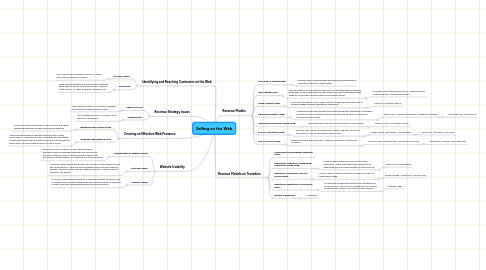
1. Revenue Strategy Issues
1.1. Channel Conflict
1.1.1. When sales activities on a company's Website interfere with its existing sales outlets
1.2. Cannibalization
1.2.1. Loss of traditional sales of a product to its electronic counterpart
2. Creating an Effective Web Presence
2.1. Identifying Web Presence Goals
2.1.1. The business needs to identify image-creation and image- enhancing objectives in order to be proven effective
2.2. Achieving Web Presence Goals
2.2.1. Attractive web presence objectives must be met in order be successful. Objectives include: Making the site interesting enough that visitors stay and explore, Building trusting relations with visitors, and encouraging visitors to return to site
3. Website Usability
3.1. Meeting Needs of Website Visitors
3.1.1. Business that are successful on the Web understand that every visitor is a potential customer and can arrive at the site for reasons such as: Learning about products that are offered, Buying products, or Obtaining info on the products
3.2. Trust and Loyalty
3.2.1. Customers when buying on the Web not only pay for the product but also pay for the service. Trust and loyalty between buyer and seller needs to happen. Services include: delivery, handling, security, customer service, and after-sale support
3.3. Usability Testing
3.3.1. A process of testing and evaluating a company's website for ease of use. In essence, this testing methods allows the visitor/customer to comment on what they think the website does well and what it doesn't
4. Identifying and Reaching Customers on the Web
4.1. Personal Contact
4.1.1. Firm's employees individually search for, qualify, and contact potential customers
4.2. Mass Media
4.2.1. Firms prepare advertising and promotional materials about the firm and its products/services. Mediums could include: TV, radio, billboards, magazines, etc
5. Revenue Models
5.1. Mail Order or Catalog Model
5.1.1. revenue model of selling goods and services through physical catalogs to establish a brand image
5.2. Web Catalog Model
5.2.1. revenue model of selling goods and services over the Web wherein the seller establishes a brand image that conveys quality and uses the strength of that image to sell through catalogs mailed to prospective buyers
5.2.1.1. Computer and Consumer electronics, Clothing retailers, Flowers and Gifts, General Discounters
5.3. Digital Content Model
5.3.1. Firms that own written info or rights to that info have embraced the Web as a new and highly efficient distribution mechanism
5.3.1.1. Lexis.com, ProQuest, EBSCO
5.4. Advertising Support Model
5.4.1. Model which Web sites provide free content along with advertising or messages provided by other companies that pay the Web site operator for delivering the advertising message.
5.4.1.1. Web Portals, Newspaper publishers, targeting classifieds
5.4.1.1.1. autotrader.com, Monster.com
5.5. Advertising Subscription mixed Model
5.5.1. subscribers pay a fee and accept some level of advertising.
5.5.1.1. NewYork Times, Wall Street Journal
5.6. Fee-for-Transaction Model
5.6.1. business offer services for which they charge a fee that is based on the number or size of transactions they process
5.6.1.1. Travel Agents, Auto Brokers, Stockbrokers
5.6.1.1.1. Travelocity, Autobytel, AmeriTrade
5.7. Fee-for-Service Model
5.7.1. Revenue model in which payment is based on the value of the service provided
5.7.1.1. Online Gaming, Concerts/Films, Professional Services
5.7.1.1.1. Intertainer, Movielink, Law on the Web
6. Revenue Models on Transition
6.1. Subscription to Advertising-Supported Model
6.2. Advertising-Supported to Advertising- Subscription Mixed Model
6.2.1. Model in which subscribers pay a fee to view a publication. These publications are usually free of advertising and can be downloaded to subscribers PC
6.2.1.1. Salon.com online Magazine
6.3. Advertising-Supported to Fee-for- Service Model
6.3.1. Model in which a paid subscription is based on amount of subscription usage
6.3.1.1. Online Storage - Xdrive tech., IBackup, Kela
6.4. Advertising-Supported to Subscription Model
6.4.1. An advertising-supported model plus a fee-based info access service. Users pay for individual articles instead of paying a set amount of access to multiple articles
6.4.1.1. Northern Light
6.5. Multiple Transactions
6.5.1. New node
